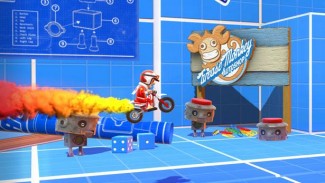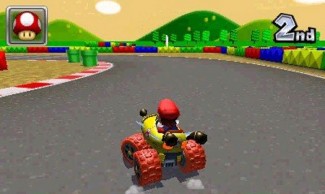Dreams
LQ: 9.8
Recommended Age: 12+
Skills Used: Flexibility, Self-Control, Coding, Mathematics, Reading, Writing
Recommended LWK Games: Mario Kart Wii, Mario Kart 7, WipEout HD, Trails HD, Joe Danger, LightBike 2
Popular M-Rated Games: Twisted Metal, Driver Renegade, Armageddon Riders
Common Thinking Skills Used: Working Memory, Flexibility
One of the oldest genres of video games, racing games still offers some of the most popular titles around. While most Racing Games place the player in control of a vehicle, with the general objective being to navigate the race course in the shortest amount of time possible, this genre encompasses a wide variety of visual styles and gameplay mechanics. Most racing games fall into one of two categories: Simulation Racing Games or Arcade Racing Games. With Simulation Racing Games, the player is usually placed in the driver’s seat of an extremely realistic vehicle (which may be an airplane, car, morotrcycle, etc.), with difficult controls and graphics. Arcade Racing games, on the other hand, tend to have more cartoon-type graphics, and often include easier controls, as well as unrealistic powers and gameplay mechanics. In both cases, however, the basic objective of all racing games remain the same, which is to be the first one across the finish line in order to win the race.
Adapting and adjusting to changing conditions and expectations.
 Racing games are good for kids who have trouble reacting quickly to novel situations. In most racing games, players must be able to make quick decisions regarding the best path of action to take, while avoiding the different obstacles and competitors that get in the way. If players do not react quickly enough or make the right decision, they may be driven off the road and could ultimately crash. When this happens frequently, it makes it harder and harder to catch back up and win the race. This use of Flexibility skills in racing games helps players practice adjusting to new situations an adapting to unforeseen obstacles.
Racing games are good for kids who have trouble reacting quickly to novel situations. In most racing games, players must be able to make quick decisions regarding the best path of action to take, while avoiding the different obstacles and competitors that get in the way. If players do not react quickly enough or make the right decision, they may be driven off the road and could ultimately crash. When this happens frequently, it makes it harder and harder to catch back up and win the race. This use of Flexibility skills in racing games helps players practice adjusting to new situations an adapting to unforeseen obstacles.
Recalling and retaining information in our mind while working.
 Most racing games contain multiple tracks that are each unique in its own way and many are riddled with obstacles and “power-ups” along the way. Power-ups help players to complete the track faster, while the obstacles threaten to slow players down. Players will have to use their Working Memory remember where they are on the track so that they can know when to speed forward and when to use caution. The better players memorize the various facets of a track’s layout, the better they’ll be able to navigate it speedily.
Most racing games contain multiple tracks that are each unique in its own way and many are riddled with obstacles and “power-ups” along the way. Power-ups help players to complete the track faster, while the obstacles threaten to slow players down. Players will have to use their Working Memory remember where they are on the track so that they can know when to speed forward and when to use caution. The better players memorize the various facets of a track’s layout, the better they’ll be able to navigate it speedily.
Our Make it Work activities are designed to transform your child’s gameplay to real-world improvements in thinking and academic skills. If you’re just getting started with LearningWorks for Kids, we suggest you try them all to find which are the best for you and your child.
Read over the pages for Flexibility and Working Memory. Then take some time to introduce these thinking skills to your child.
Explain that:
 Make mistakes. Showing your child that you are not afraid of making mistakes and that you aren’t afraid to laugh at yourself, might allow him to laugh at his own errors. Show that you are able to learn from making a mistake. This is very easy. You can make a mistake by going the wrong way to an activity, mixing up ingredients in a recipe, making a hole in the wall while you are trying to hang a picture, or making an error while trying to complete a crossword puzzle or Sudoku. Encourage your children to talk about how they are able to learn from making mistakes.
Make mistakes. Showing your child that you are not afraid of making mistakes and that you aren’t afraid to laugh at yourself, might allow him to laugh at his own errors. Show that you are able to learn from making a mistake. This is very easy. You can make a mistake by going the wrong way to an activity, mixing up ingredients in a recipe, making a hole in the wall while you are trying to hang a picture, or making an error while trying to complete a crossword puzzle or Sudoku. Encourage your children to talk about how they are able to learn from making mistakes.
 Conduct a “memory project” in which you and your children brainstorm methods to make it easier to remember daily activities. This could include putting backpacks by the door in the evening to be remembered for school in the morning; designating a drawer in the kitchen for children’s papers, money, and other school materials; and using cell phones as a calendar. Compare levels of success using new strategies versus older methods and then discuss what has and has not helped.
Conduct a “memory project” in which you and your children brainstorm methods to make it easier to remember daily activities. This could include putting backpacks by the door in the evening to be remembered for school in the morning; designating a drawer in the kitchen for children’s papers, money, and other school materials; and using cell phones as a calendar. Compare levels of success using new strategies versus older methods and then discuss what has and has not helped.
Racing games are among the easiest and most enjoyable video games for parents to play with their kids. In general, the rules are simple, the goals are clear, and most of them are made for more than one player. With a little practice, you might even have a chance to win a few games!
Racing games are also great because very few of them have mature content or significant violence, and as a result are usually suitable for the entire family to play.
A great way to get involved with your child’s gaming is to ask him to teach you how to play–and racing games are a perfect opportunity to do this. Ask your child to explain the goals and rules of the game, and then have him demonstrate how to use the controller. If you haven’t played many video games recently, explain to them that you may need some basic instructions about the different buttons, sticks, and triggers on the controller.
Racing games are also a good opportunity to teach your child how to handle frustration. Even the best players will crash, burn, and lose control of their automobile. As a novice, you are likely to find yourself ricocheting from one wall to another, flipping over time and time again, and driving far behind your kid and other players. Demonstrating how you can have fun while making mistakes, and at the same time have the desire to learn how to get better, can be an important lesson for your child. You may want to acknowledge your level of ineptitude, while asking your child for advice and help on how to improve your skills. You might even want to draw a parallel to an activity that your child was once a novice at, such as a sport, a musical instrument, or an academic subject.
We really encourage you to play racing games with your kids. It’s an easy and fun way to enter into their world of video games, and a great opportunity for making your child’s video game play a topic of family conversation.
All membership plans come with full access to our entire suite of tools learning guides, and resources. Here are a few of the ones we think you’ll like the most: